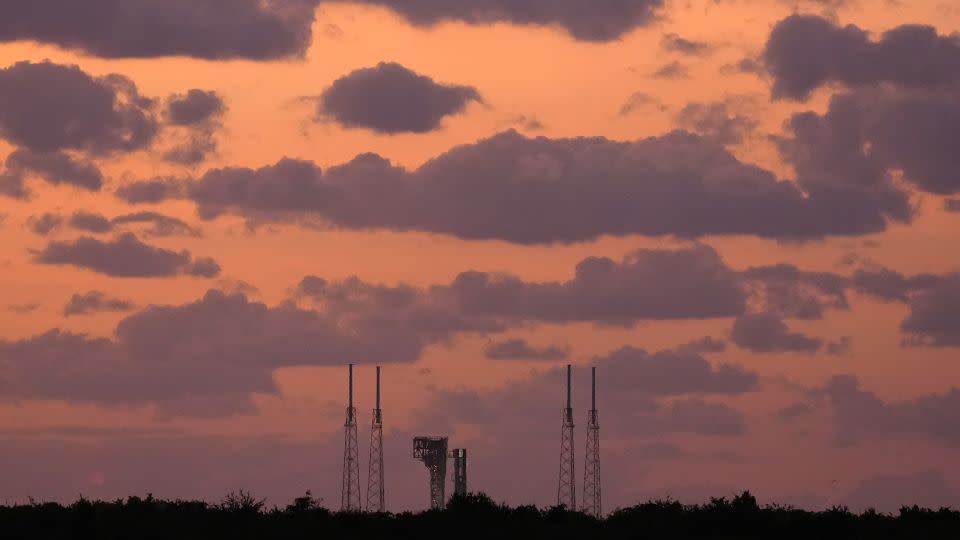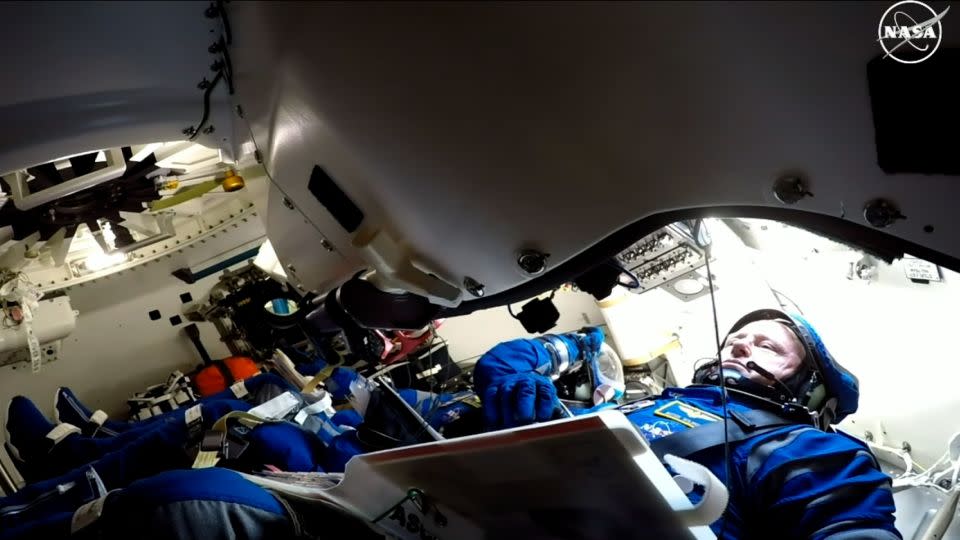Boeing calls off historic mission carrying two astronauts minutes before liftoff

Sign up for CNN’s Wonder Theory science newsletter. Explore the universe with news on fascinating discoveries, scientific advancements and more.
The launch of Boeing’s Starliner, which aimed to lift off on its crewed maiden voyage Saturday, has been scrubbed.
The new spacecraft was expected to lift off atop an Atlas V rocket at 12:25 p.m. ET from Cape Canaveral Space Force Station in Florida, carrying veteran NASA astronauts Butch Wilmore and Suni Williams.

But an automatic hold triggered by the ground launch sequencer, or the computer that launches the rocket, stopped the countdown clock at 3 minutes and 50 seconds ahead of launch. Teams safely extracted the astronauts from the capsule, and Williams and Wilmore returned to crew quarters to await their next steps.
NASA announced late Saturday that it will not attempt to launch the Starliner on Sunday. The next available opportunity to lift off is Wednesday at 10:52 a.m. ET., however the agency indicated mission teams have not yet determined whether they will attempt to launch the spacecraft then. There is another backup launch window on June 6.
Tory Bruno, president and CEO of United Launch Alliance, which built the Atlas V rocket Starliner sits atop, said to assess the issue that caused the launch scrub, teams will have to get hands-on this evening with the ground launch sequencer.
Once the rocket has been drained of fuel, teams will be able to assess the triple-redundant computer system at the launchpad.
“Imagine a large rack that is a big computer where the functions of the computer as a controller are broken up separately into individual cards or printed wire circuit boards with their logic devices. So they’re all stand-alone, but together it’s an integrated controller,” Bruno said. “And we do that to make it easier to troubleshoot them, to swap out parts so that you can replace just one element of it without having to replace the whole thing.”
All three computers have to agree for launch to occur, Bruno said.
“The third one was slow to come up and that tripped a red line — that created an automatic hold because, although the health system did not note that it came up anomalously, it took longer, and so something is not correct,” Bruno said.
“We’ll know more, much, much later this evening,” he added.
Other issues occurred prior to the scrub.
Around 10 a.m. ET, mission teams reported a loss of data from ground valves responsible for replenishing the liquid oxygen and hydrogen to the second, or upper stage, of the Atlas V rocket. Both liquid oxygen and hydrogen, used to fuel the rocket, boil off as the rocket sits on the pad ahead of launch, so replenishment is ongoing until liftoff.
After evaluating the issue, which prevented the hatch from closing after the astronauts entered the crew capsule for about 45 minutes, mission teams switched to a redundant system for the valve data. Then, teams resumed replenishing liquid hydrogen and oxygen. Fortunately, mission teams were ahead of the expected timeline when the issue occurred, and the countdown to launch resumed, according to the live NASA broadcast.
The valve issue did not cause any safety concerns for the crew, and the hatch on Starliner closed around 11:20 a.m. ET.
The mission, called Crew Flight Test, is the culmination of Boeing’s efforts to develop a spacecraft to rival SpaceX’s Crew Dragon capsule and expand US options for ferrying astronauts to the space station under NASA’s Commercial Crew Program. The federal agency’s initiative aims to foster collaboration with private industry partners.
Boeing Crew Flight Test mission goals
When Starliner does launch, the flight would mark only the sixth inaugural journey of a crewed spacecraft in US history, NASA Administrator Bill Nelson noted in a May news conference.
“It started with Mercury, then with Gemini, then with Apollo, the space shuttle, then (SpaceX’s) Dragon — and now Starliner,” Nelson said.
Williams will also make history as the first woman to fly aboard such a mission.
After reaching orbit, the Starliner crew capsule carrying Wilmore and Williams will separate from the Atlas V rocket and fire its own engines. Starliner is expected to spend more than 24 hours traveling to the International Space Station.
The astronauts will test various aspects of Starliner’s capabilities, including the spacecraft’s thruster performance, how their spacesuits function within the capsule, and manual piloting in case the crew needs to override the spacecraft’s autopilot.

The astronaut duo will join the seven astronauts and cosmonauts already on board the space station and spend eight days on the orbiting laboratory.
The astronauts will test Starliner’s “safe haven” capability, designed to offer the space station crew a shelter if there is a problem on the space station, according to Steve Stich, manager of NASA’s Commercial Crew Program, who spoke during a Friday news conference.
When it’s time to head home, Williams and Wilmore will return using the same Starliner capsule and land at a site in the southwestern United States.
The earliest possible return for Williams and Wilmore is June 10, but there are other dates available in case of bad weather conditions, Stich said.
A series of delays
Years of development hang-ups, test flight problems and other costly setbacks have slowed Starliner’s path to the launchpad. Meanwhile, Boeing’s competitor under NASA’s commercial program — SpaceX — has become the go-to transportation provider for the space agency’s astronauts.
This mission could be the final major milestone before NASA deems Boeing’s Starliner spacecraft ready for routine operations to deliver astronauts and cargo to the space station.
“We look forward to flying this mission. This is a test flight; we know we’re going to learn things,” said Mark Nappi, vice president and program manager of the Commercial Crew Program at Boeing, in a statement. “We are going to improve, and that improvement starts with the Starliner-1 mission and it will be even better than the mission we’re about to fly.”
Starliner was only about two hours from its first crewed launch attempt on May 6 when engineers identified an issue with a valve on the second stage, or upper portion, of the Atlas V rocket. The entire stack, including the rocket and spacecraft, was rolled back from the launchpad for testing and repairs.
Then, mission teams reported a small helium leak within the spacecraft service module. The leak was traced to a part called a flange on a single reaction control system thruster, where helium is used to allow the thrusters to fire.
The space agency said the leak did not pose a threat to a mission.
“We looked really hard at what our options were with this particular flange,” he said. “A fuel line, an oxidizer line and a helium line all go into the flange, which makes it problematic to work on. It makes it almost unsafe to work on.”
Rather than making a replacement to fix the leak, the teams decided that the helium leak is small enough to be manageable, Stich said.
“When we looked at this problem, it didn’t come down to making trades,” Nappi said. “It came down to, ‘is it safe or not?’ And it is safe. And that’s why we determined that we could go fly with what we have.”
During the launch countdown Saturday morning, mission teams monitored the leak, and so far, no issues have been reported. The teams have spent the past two weeks assessing acceptable levels for the helium leak and troubleshooting, which have been laid out in the rulebook that engineers will use, Nappi said.
While evaluating the helium issue during the lead-up to launch day, engineers also spotted a “design vulnerability” in the propulsion system — essentially identifying a remote scenario in which certain thrusters might fail as the vehicle leaves Earth’s orbit, without a backup method of getting home safely.
NASA and Boeing have since worked with the vendor of the thruster to come up with a backup plan to perform the deorbit burn, should that situation arise, Stich said in a May 24 news conference.
“We have restored that redundancy for the backup capability in a very remote set of failures for the direct burn,” Stich said.
After a flight readiness review meeting on May 29, leaders from NASA, Boeing and United Launch Alliance, which built the rocket, “verified launch readiness, including all systems, facilities, and teams supporting the test flight,” according to the space agency.
The mission teams also took a close look at Starliner’s parachutes after one parachute on Blue Origin’s recent suborbital crewed flight failed to fully inflate. Starliner uses components that are similar to that parachute system, Stich said.
Blue Origin shared flight data with Boeing and NASA, and after assessing Starliner’s parachutes, the team deemed them “good to fly.”
Last-minute packing
The space station experienced an anomaly on Wednesday that Starliner could help fix, said Dana Weigel, manager for NASA’s International Space Station Program.
A pump on the station’s urine processor assembly has failed.
“That urine processor takes all of the crew’s urine and processes it in the first step of a water recovery system,” Weigel said. “It then sends it downstream to a water processor which turns it into drinking water. The station’s really designed to be a closed loop.”
The pump was expected to perform until the fall, and a replacement was set to fly aboard a cargo resupply mission slated for August. But the pump’s failure “put us in a position where we’d have to store an awful lot of urine,” Weigel said.

Now, the urine has to be stored on board in containers. To solve this issue, a replacement pump was quickly swapped into Starliner’s cargo. The pump weighs about 150 pounds, so the team removed two crew suitcases from Starliner carrying clothes and toiletries such as shampoo and soaps handpicked by Wilmore and Williams.
There is a contingency supply of generic clothes and toiletries on the space station that the astronaut duo will use instead for their short stay, Weigel said.
Wilmore and Williams have been in crew quarantine to protect their health prior to launch since the end of April, said NASA astronaut Mike Fincke, who is slated to serve as pilot for the upcoming Boeing Starliner-1 mission that would follow a successful test flight.
“Butch and Suni have every confidence in our rocket, our spacecraft and in our operations teams and leadership management teams, and they are definitely ready to go,” he said.
Sign up for CNN’s Wonder Theory science newsletter. Explore the universe with news on fascinating discoveries, scientific advancements and more.
CNN’s Deblina Chakraborty contributed to this report.
For more CNN news and newsletters create an account at CNN.com

 Yahoo News
Yahoo News 
